News
What crypto currencies pretend to be a "cash" for everyday settlements?

The growing popularity of crypto-currencies has led to unprecedented attention to the nature of money. Such terms "Money theories" as a means of accumulation, a measure of value and a medium of circulation are becoming more and more common.
Because of its high popularity, bitcoin gradually turns from a means of circulation into a means of accumulation. Although at the beginning of its existence, the commission was quite low, so the BTC was perfectly suited for everyday calculations. Alas, these days have long passed.
Which of the thousands of crypto-currencies are capable of occupying its niche and bringing digital assets to the masses? Here is a (far from complete) list of projects that seek to become real cash in the digital era.
Litecoin (LTC)
Lightcoin is often called digital silver. It was originally intended for everyday use, and developers still adhere to this goal.
Лайткоин is one of the oldest криптовалют. He has four times more coins than bitcoin, and the creation of a block requires four times less time (therefore, payments are about four times faster).
Because of its origin (the developers used the bitcoin code), lightcoin usually follows the bitcoin relentlessly. The affinity of the two projects allows LTC holders to open payment channels in the Lightning network. In the future, this should increase the popularity of the crypto currency and make it more accessible to a wide range of consumers.
Bitcoin Cash (BCH)
Bitcoin Cash appeared as a result of the split over the SegWit protocol update and the increase in the bitcoin block size. He was preceded by a lengthy debate about the advantages and disadvantages of each option.
Block size of 8 MB helped improve the processing speed of transactions. Supporters of Bitcoin Cash claim that thanks to this, the crypto currency has become a real medium of circulation.
Dash (DASH)
Dash is a reduction from digital cash. As the name implies, the project from the very beginning sought to occupy this niche in the market. It's like a lightcoin is a branch from bitcoin and differs from the original with additional security features.
Dash was the first to implement the concept of master programs (super nodes). Although some members of the crypto-currency community have criticized it, it is the master programs that make it possible to conduct the so-called InstantSend. It will help Dash to gain popularity as a universal digital currency. Currently, Dash is very in demand in South America.
Dogecoin (DOGE)
Ironically, today Dogecoin is a fairly popular crypto currency. Perhaps its success is due to a rather frivolous attitude on the part of users – they just do not see in it a means of accumulation and willingly spend.
At the time of writing, Dogecoin ranks third in the number of daily active wallets – after bitcoin and ether.
Monero (XMR)
Monero is probably the most popular anonymous crypto currency at the moment (and not just in darknet, as one might assume from its characteristics).
Monero is also popular with software developers due to its democratic approach based on open source. Decentralization is extremely important for security and is not a trivial technical issue – excessive centralization of the community of programmers working on crypto currency can make it vulnerable to repressive actions by the authorities. That's why Monero is so popular with political activists and organizations like WikiLeaks.
Zcash (ZEC)
Another popular anonymous crypto currency. Zcash (originally Zerocoin) originates from the Bytecoin project. For several years, a team of experienced scientists has been working to make Zcash the most effective and safe means of transferring value through the Internet. The methods of maintaining anonymity, laid by professional mathematicians and cryptographers, stimulate the popularity of Zcash in conditions of increased demand for confidentiality.
The zero-disclosure method of evidence underlying Zcash is now widely discussed by cryptographers and computer security specialists. Originally it was developed by one of the founders of Zcash, Alessandro Kyessoy.
CitiCash
CitiCash is a new player in the market with an integrated promotion strategy. The team develops software in such a way as to make it as easy as possible to work with crypto currency: with short, simple addresses and convenient applications. This is combined with a comprehensive strategy of promotion aimed at the broad masses.
In addition to tools for protecting privacy, CitiCash also has a built-in inflation mechanism. It stimulates the use, not the accumulation and storage of crypto currency.
Nano (NANO)
At the heart of Nano (formerly RaiBlocks) is the model of decentralized acyclic graphs (DAG). Supporters of crypto currency like to emphasize the fact that transactions pass without commissions and are usually confirmed within 10 seconds. Nano is easier to take the place of traditional currencies, since the DAG structure greatly simplifies the scaling.
Theoretically, Nano can process arbitrarily large number of transactions. Currently, the network is capable of carrying out about 7,000 operations per second under ideal conditions; in real conditions it was possible to reach a speed of 300 transactions per second. However, even its current level is much higher than the bandwidth of other popular crypto-currencies based on the blockbuster.
Verge (XVG)
Despite the numerous charges of fraud, the relatively new Verge (fork Dogecoin) crypto currency boasts an exceptionally active user base.
Part of its popularity is due to the rapid rise in prices caused by the active support of the well-known businessman and crypto-enthusiast John McAfee and, as some are convinced, a deliberately agitated frenzy about the underlying technology.
For the sake of fairness, it should be noted that Verge has really good technical characteristics and, like most popular crypto currency, focuses on confidentiality.
The project recently signed a partnership agreement with Pundi X, a start-up that develops the technology of crypto-currency payments in retail stores. Collaboration with Pundi X will help the wider distribution of Verge.
Electroneum (ETN)
Electroneum is targeted at mobile applications and low-end users who access the Internet exclusively from their smartphones. Crypto currency has a promising model, but so far it suffers from low speed of operation.
Which crypto currency will be the most popular medium of circulation?
Any digital currency that seeks to replace dollars and euros must have the following characteristics:
- Stability: In order for a crypto currency to become an effective means of payment, people should start thinking in its units. This requires maximum stability and a balance of supply and demand. If inflation exists in the system, who benefits from it?
- Widespread : Money depends entirely on the network effect. A significant share of their cost is tied to practicality, and practicality is growing along with popularity.
- Incentives: There must be a good reason to use this crypto currency. According to the law of Gresham, people spend that currency, which, in their opinion, loses its purchasing power. Accordingly, they postpone the currency, the value of which is growing.
- Scalability: The currency should provide trouble-free transactions in a rapidly growing user base.
- Ease of use: Acquisition, storage and use of crypto currency should be as simple and convenient as possible.
It is difficult to say which of the above projects will be the winner in this race, if you evaluate them in the above categories.
Currently, lightcoin is the most famous and popular digital currency out of those mentioned in this article. However, if the theoretical constructs of Nano prove to be correct, its network will be able to conduct the maximum amount of transactions.
Conceptually, the way to the widest distribution lies, perhaps, in the combination of the most convenient and understandable mobile wallets with a serious marketing campaign (as in the case of Electroneum and CitiCash).















